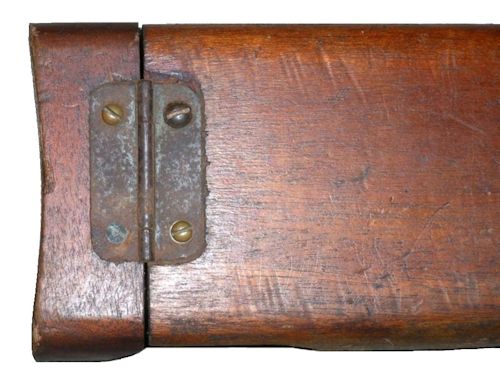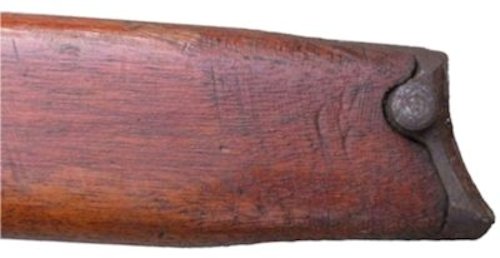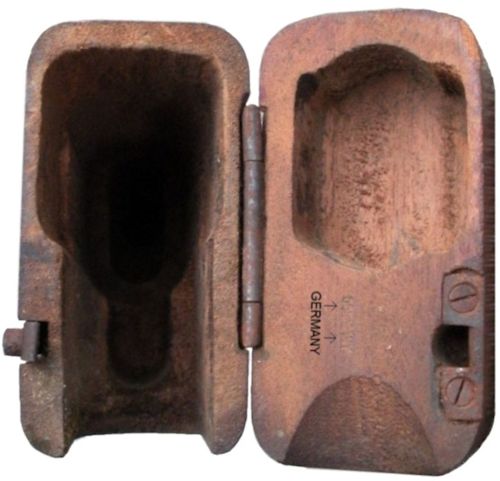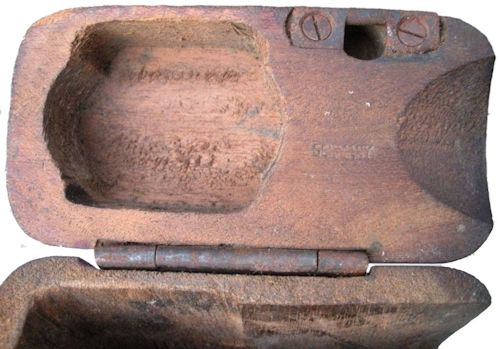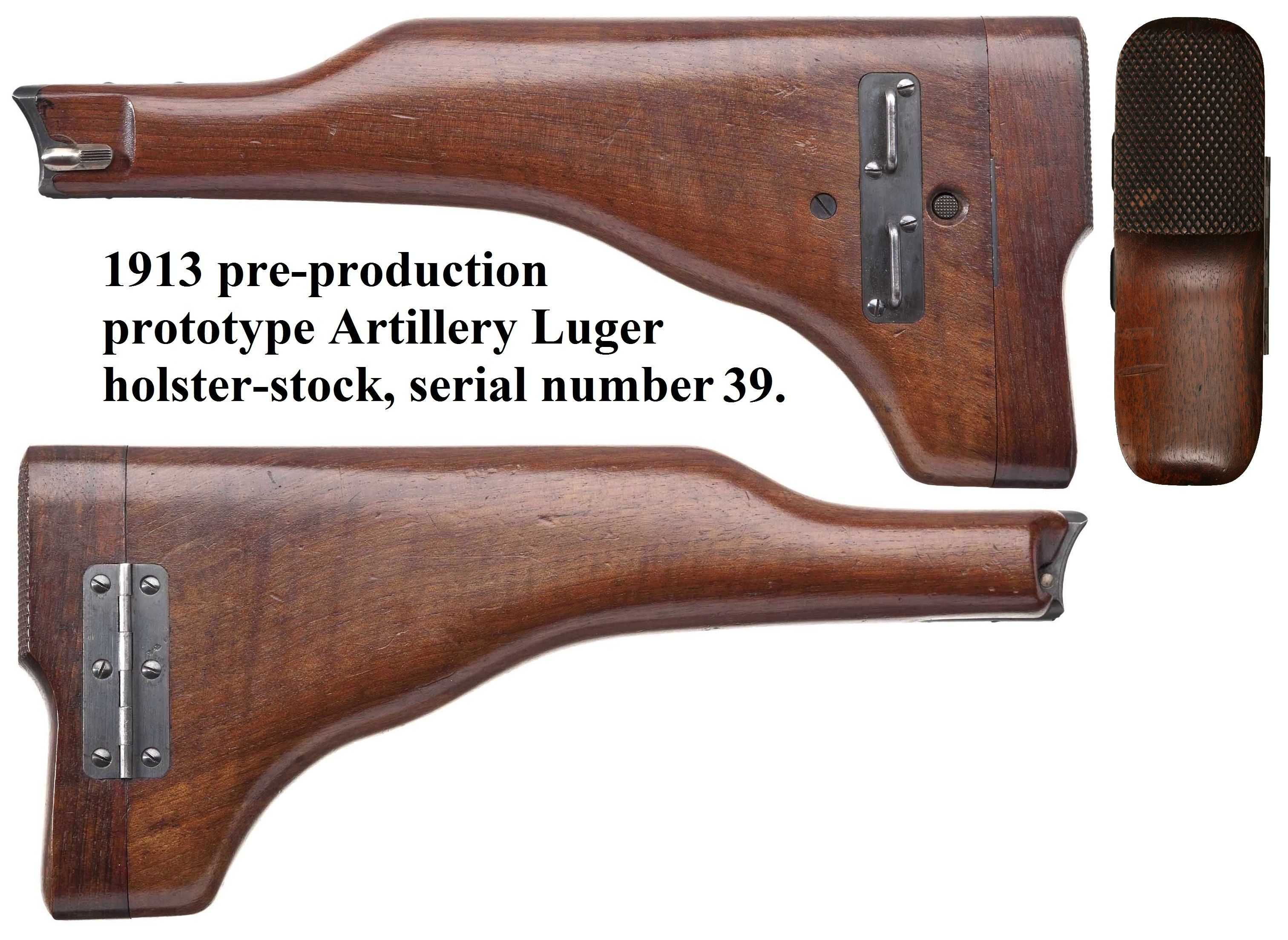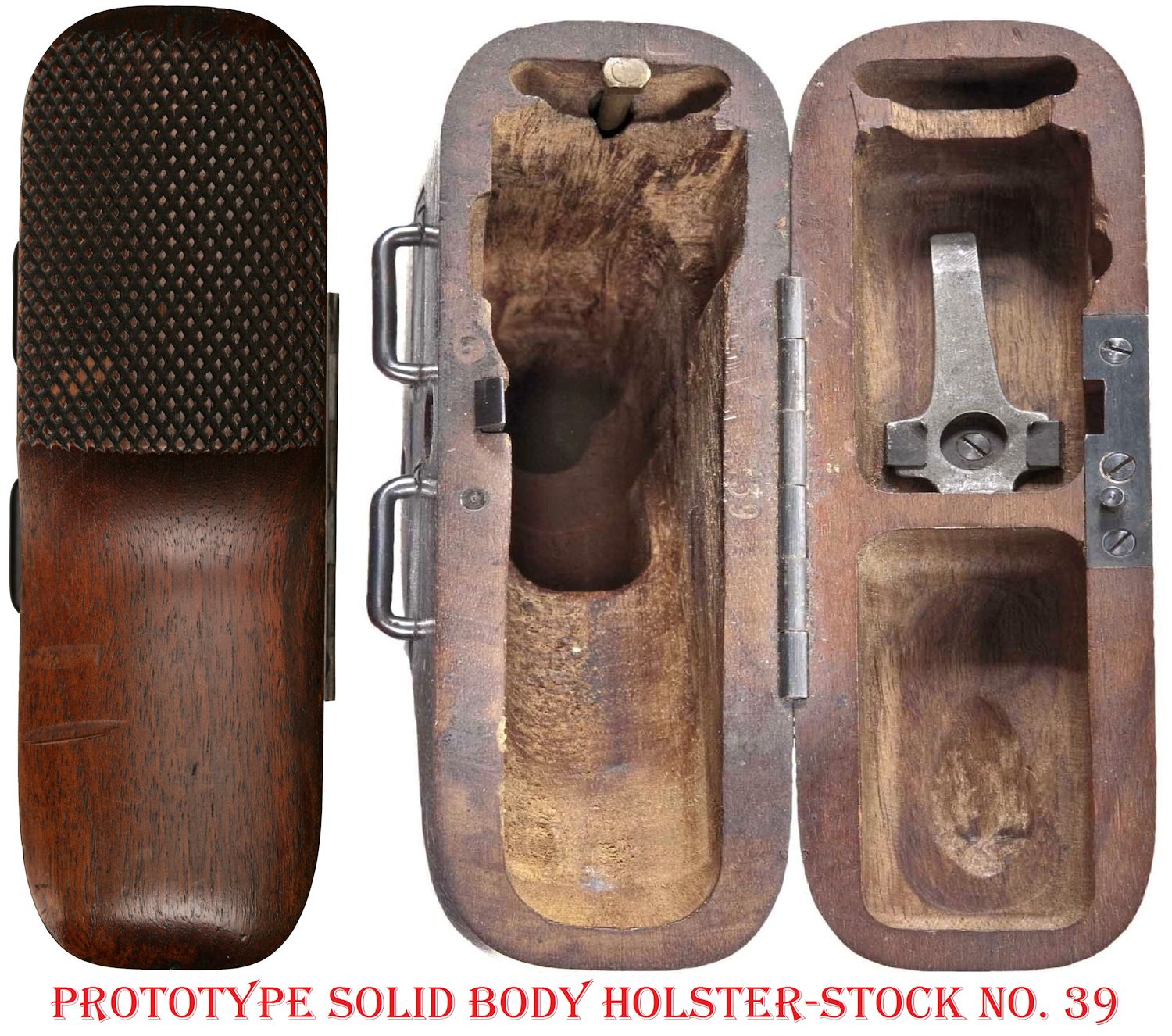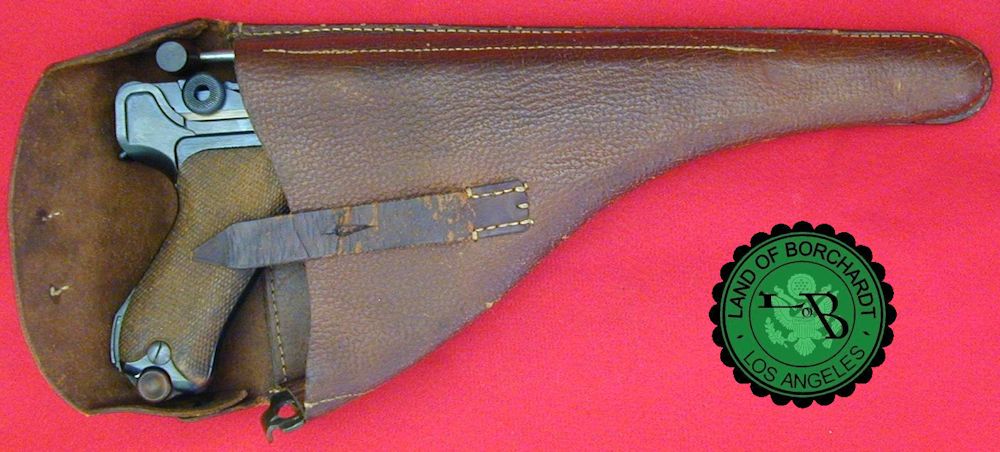buttons

Mouse over to see right side.
Pictured above is a very rare 1912/1913 pre-production Prototype Artillery Luger, serial number 11. One of approximately 20 Troop Trials Prototype guns used by the German Air Service for tests in 1913 as defined by Görtz/Sturgess in the 2010 publication Pistole Parabellum. The gun was subsequently described in text and pictures to world renown collector Dr. G.L. Sturgess, who owns serial number 4, pictured and described in Pistole Parabellum, Volume 1, Chapter 17, pages 396, 397 and 409, who immediately recognized it as an original and very rare pre-production Artillery Luger prototype.
The equally rare accessory, the Solid-Body Prototype/Trials LP.08 Holster-Stock, which was supplied with these guns, first appears in Luger literature in 1969 in Lugers at Random by C. Kenyon, however, apparently, with no knowledge of the connection or association to the pre-production prototype Artillery Luger variation, simply described it as: A very rare and one-of-a-kind accessory, the implication being only one. 1976 in a book titled: Luger Tips, Edition 1 by Michael Reese II gets close to properly identifying the holster stock, picturing an example with the caption, with only the incorrect date of 1914 which should be 1913 : The “1914” Experimental Artillery Stock. This is the rarest Luger stock known to exist and that he has seen two “different” types of prototype stocks, both were for “Artillery” models, both seemed to be 100% original.
The earliest information that can be found on the solid-body holster stock was written by the late Fred A. Datig in the first 1955 printing of his benchmark, limited printing, special private edition (#780) book on Lugers titled: THE LUGER BOOK (Pistole Parabellum), Copyright © 1955 on page 177 where he states: A very scarce stock is the hollow-holster stock which resembles, to some extent, that used in conjunction with the Mauser Military pistol. As with the Mauser, the Luger holster-stock has a wooden, hinged lid which is held shut by means of a spring loaded catch. Upon pressing the catch, the lid may be opened and the pistol (8 inch barrel) inserted, leaving only the grip of the pistol protruding3. Datig is describing what is now known as an example of late 1920s early 1930s “aftermarket” versions of holster-stocks for the Luger with standard turn-lever attaching irons, similar examples being offered for sale by A.F. Stoeger in their 1929-1930 catalog and 1930/31 winter catalogs. Pictured is the 1928 Stoeger catalog ad with its conspicuous lack of the No. 750 item description of the “Combination wooden stock and holster for the Luger vs. the 1930 Stoeger catalog addition of the No. 750 description, both in the numbered item list to the right and the added paragraph text description to the left, with the initial ad for the Luger holster-stock first appearing in the 1929 Stoeger catalog and last or final ad being in the 1932 Stoeger catalog, apparently not a popular item, discontinued in only four years.
The most interesting Datig comment is found in a footnote (3) of his above general description of the holster-stock, found on page 182 of his 1955 publication where he makes the incredible, unsubstantiated statement: 3. Hollow wooden holster-stocks were available on special order from the DWM factory since 1900.
In his last book written in 1990 by Datig titled: The Luger Pistole (Pistole Parabellum), Monograph II - The German Military Pistols 1904 – 1930, Datig pictures the same, identical Holster-Stock pictured in his 1955 book, except without a Luger inserted on page 61, but with the caption: Experimental combination Holster-Stock for the “Lange Pistole 08” (Long Pistol 08). The only specimen seen; origin unknown, and on page 80, attached to an Artillery with a similar text caption, which in actuality has been subsequently identified as an unknown variation, somewhat similar to the Mauser C96 Broomhandle pistol holster stock, where the grip handle protrudes through a hole in the bottom of the holster stock, which, in this case is a Luger. An actual original of the holster stock pictured in Datig’s books has been identified, revealing some unique features, such as an unusual type of push-button attaching iron.1 The unusual holster-stock is stamped GERMANY in two locations, imbuing some form of legitimacy to the variation, however, per comments from G. Sturgess: Until it is found to be pictured in some old catalog it has to be relegated to a curiosity. Despite not being identified/pictured in any publication to date, apparently there were more than one made, as the Datig black & white pictures, in both his 1955 and 1990 publications, shows an added attachment at the base or neck of the holster-stock, possibly used for some form of a carrying strap, which is not seen on two other identified examples described below.
Pistole Parabellum, figure 1345 caption description states that the pictured Mauser C96 style holster-stock made, in this case, for an Artillery Luger, courtesy: Robert Simpson is identical to the to the 1929 Stoeger ad No. 750 described, but not pictured Artillery Luger style holster-stock, presumably with a turn-lever type attaching iron. The Pistole Parabellum, figure 1345 description and picture is referenced in a Simpson Ltd. web site ad, now being a “signature” item1, to promote the identical holster-stock pictured in figure 1345, interestingly, with the author of Pistole Parabellum not acknowledging the book or is contents as accurate. Nevertheless, since the 1929 Stoeger catalog description, which is, coincidently, in the 1930 Stoeger Catalog 14 and in the 1930 - 1931 winter catalog 15, is a text description only, without any supporting picture, and therefore, there is the possibility that the pictured turn-lever attaching iron Artillery Luger holster stock is not the Stoeger catalog offering and that the catalog is describing the late 1920s – early 1930s Artillery Luger push-button holster-stock or possibly both.
Additionally, it is difficult to accept the Pistole Parabellum/Simpson example as being the holster-stock described in the Stoeger catalogs as: A new combination wooden holster and stock combined, purchased through the catalog in the United States when it has an unidentified crown over KM stamped on the wood and a serial number stamped on the attaching iron and lacking any GERMANY export stamps. In summary, Stoeger was offering a new, unmarked product and that the Pistole Parabellum/Simpson example was not the Stoeger described new product and not sold through the catalog. Another explanation is needed for the origins of the Pistole Parabellum/Simpson holster-stock example.
Pictured in this article are three examples of the late 1920s, early 1930s Artillery Luger push-button holster-stock, with two published black and white examples, one belonging to the late Pat Redmond Collection, published in the 1986 Gun Collector’s Digest on page 15 with a text caption description claiming it to be “similar” to the to the Mauser “Broomhandle” stock and that: These type of stocks were listed in the 1929 Stoeger catalog. As stated earlier, an original push-button example has been identified, being one of the three examples is and is considered genuine and of period German manufacture, based on its overall appearance and of two Germany export stamps. With three push-button examples identified vs. only one turn-lever example supports the supposition that the sole turn-lever example, until more are identified, is spurious in nature and the that push-button example is a very desirable collectable, as described in the Stoeger catalogs.
The LUGER Snail Drum and other accessories for the Artillery Model Luger published in 2010 by Edward C. Sayre describes, quite accurately, the Model 1913 Holster Stock for the LP.08, properly giving photographic credit to prior authors, Charles Kenyon, Luger: The Multi-National Pistol and the late Fred Datig, The Luger Pistol for their pictures of original M1913 holster stocks, however, inadvertently credits the Datig picture as an original M1913 Artillery holster-stock. This author does not show an original M1913 holster stock but pictures a much later, similar, but not identical, reproduction aftermarket M1913 Holster stock stating: This high-quality reproduction was limited to 150 units and that the M1913 holster stock was also available in a different style cover hinge in the 1929 Stoeger catalog, which, as stated above is an aftermarket commercial offering, being a totally different configuration than the original M1913, not enclosing the entire pistol as does the original 1913 variation. This 1930s Mauser pattern Artillery holster-stock is pictured and described in Pistole Parabellum, Volume III, Chapter 17, page 1418. Pictured are several views of an example of the pictured and described circa 1913 aftermarket reproduction Artillery holster stock in the Edward C. Sayre book on page 90, compared against an original circa 1913 with the differences highlighted with a circle. The comparisons between the original and the aftermarket reproduction Artillery Luger holster-stocks in profile are clearly evident. The really stark differences are found in the holster-stock body opening and the hinged lid recess. Regarding the external differences in the butt plate contours and finish are with the aftermarket example having a plain finish and symmetrical contour in profile vs. the hatching pattern and unusual contour in profile of the original. It is unclear why the craftsman that made the aftermarket reproduction pieces, obviously using modern NC programing, did not take the effort to completely replicate the original, with the only possible explanation being that he was only working with pictures and not an original example and even then, inexplicably, got the hinge wrong. Per G. Sturgess there are other aftermarket reproduction Artillery Luger solid-body holster-stocks that come very close to the original vs. the Edward C. Sayre example described and pictured on page 90 of The LUGER Snail Drum and Other Accessories for the Artillery Model Luger: (The Sayre) examples are different from earlier ones that were touted as fakes some years ago, as they were made from two planks of wood, inlet before gluing together, which made them very easy to spot once you knew this, but they were a closer copy in shape, and the stock lid/butt plate was shaped and chequered like the original as I recall, and the hinge was also the same size as the original.
As of this writing there are at least three identified original solid-body holster-stocks for the 1913 pre-production prototype Artillery Luger series, all three identified with stock numbers, with two examples out of the three with incorrect attaching iron serial numbers, indicating possibly renumbered or replaced attaching iron irons, being stock numbers 32 and 39, with holster-stock number 39 recently sold in a 2010 European auction with an attaching iron stamped 5464 and 32 pictured in Pistole Parabellum, having an attaching iron as presented, stamped with gun serial number 37. The second, unidentified solid-body holster-stock is pictured in the 1969 book: Lugers at Random turns out to be identical to holster-stock number 32 with a caption description stating a two digit, followed by a letter stamped attaching iron and the third is the only known complete matching rig, pictured in the 1991 book: Luger: The Multi-National Pistol, both publications by C. Kenyon, Jr. which the unidentified rig pictured in Kenyon Jr.’s later 1991 book has been subsequently identified to be of the late Pat Redmond Collection, being holster-stock number 52 with attaching iron stamped 37, mated to prototype Artillery Luger serial number 37. At first there were thought to be four identified holster-stocks with two of the four holster-stocks being easy to identify because of the stock numbers. The other two, without visible stock numbers, were determined to be different by a simple method of comparing the final seating slot position of the mounting screws used to attach the dual hook lanyard loop plate and the single screw securing the holster spring loaded latch to the wooden holster body. This method as it turns out, is flawed, as it depends on no changes to the attached hardware from original 1912/13 manufacture to the present. However, further scrutiny of the 1969 Lugers at Random holster-stock pictured on page 380 as compared against the holster-stock pictured in Pistole Parabellum, identified as holster stock number 52, revealed most interesting information as discussed and pictured below. This new information required a modification to the previous table comparisons.
The 1969 publication Lugers at Random by C. Kenyon shows the unidentified prototype Artillery holster-stock as part of the then John Gabrick Collection with a caption describing the attaching iron as having a two-digit serial number followed by a letter. G. Sturgess states in correspondence that: … the one as a rig that Pat Redmond had in the U.S. years ago, which was sn 37 (pistol and stock iron)/sn 52 (on the wood internally). Sturgess is, therefore, no doubt, referring to the unidentified rig pictured in the 1991 publication Luger: The Multi-National Pistol by C. Kenyon picturing the only known, completely original and matching prototype Artillery Luger rig with prototype Artillery Luger serial number 37 with matching stock iron stamped 37 and holster-stock stamped 52. Sturgess shows snippets of this rig in Pistole Parabellum in figure 1245 showing the left and right side of holster stock number 32 with an inset showing the top of the number 37 stamped attaching iron belong to holster stock number 52 and in figure 1246 an inset showing the number 52 stamped holster-stock, along with holster-stock stamped 32. Interesting, inasmuch as there have to be complete pictures of the late Pat Redmond Artillery Luger prototype serial number 37, and holster-stock number 52 available to Sturgess at the 2010 publication of Pistole Parabellum and that the prototype Artillery holster-stock number 32 belonging to Sturgess, prominently displayed in great detail in Pistole Parabellum does not identify the attaching iron serial number stamping, if any, instead inletting a picture of prototype Artillery Luger, serial number 37 stamped attaching iron. There is another solid-body holster-stock pictured in the 1980s Gun Collector’s Digest attributed to the late Pat Redmond Collection but due to the poor quality picture it cannot be determined if it as another or one of the three described herein.
The prototype solid-body holster-stock body shown with the cover lid open of the Pistole Parabellum holster stock, identified as stock number 52 as compared against prototype solid-body holster-stock, identified as number 39 presents some confusion as to identity. The Pistole Parabellum, figure 1246 caption claims the holster stock to be number 52, pointing to a lower left inset in the figure, with an arrow to a number 52 next to the hinge. However, to the right of the inset picture is a larger picture showing the entire lid open, clearly showing the number 32 next to the hinge. The placement or location of the 32 is consistent with the placement of the number 39 pictured to the right, of which the auction caption description states that the prototype solid-body holster-stock is No. 39 and also states that the stock number is also stamped in the wood under the fixed loading tool, which is consistent with the number 32 stamped in the same location of the Pistole Parabellum example, with the conclusion being that the Pistole Parabellum example is stock number 32 and not 52. As to what the number 52 represents is uncertain as the pictured hinge seems to be different, surrounded by a different wooden contour.
The comment in the auction description of stock No.39 that the “Collar” number is stamped 5464, presumably taken from normal shoulder stock and exchanged is telling. The collar, in this case, is the attaching stock iron and that it is a replacement, and seeing that it is a four-digit serial number, probably taken from a later LP08 production board-stock. The conclusion here is that one cannot rely on the attaching stock iron being original on any prototype Artillery solid-body holster-stock encountered. This is a very interesting observation as the solid-body holster-stock example pictured in Lugers at Random, the caption states: The attaching iron bears a two digit serial followed by a letter.
The 2010 publication, Pistole Parabellum by Görtz/Sturgess is not, as evidenced by the materiel presented above, the first publication to identify the subject pre-production prototype Artillery Luger variation and its’ accessories, as it is beautifully pictured with all its accessories, consisting of the gun, the holster-stock, and the exceptionally rare four-magazine pouch, three on the front and one on the side, leather holster, where Kenyon properly identifies the variation in his later 1991 publication titled: Luger: The Multi-National Pistol by Charles Kenyon, Jr. along with a brief opposite page, three paragraph description, stating a lot of 50 weapons submitted by DWM vs. 20 as stated by Sturgess. Kenyon states that: Examples and accessories shown are even rarer. This is the only known example, complete with all original accessories, as submitted for testing.
Pistole Parabellum discusses, at length, in Volume I, Chapter 17, pages 403 through 407 the history that led up to the adoption of the LP.08 or Artillery Luger by the German military, a.k.a. GPK, in addition to a lengthy dissertation on the specific mechanical details and other nuances of the variation with many detailed pictures, including one of pre-production prototype Artillery Luger, serial number 4 with an attached pre-production prototype holster- stock, also in Volume 1, Chapter 17, on pages 440 through 443 with a beginning statement on page 440 stating: The prototypes which have survived from the trials by the GPK in 1912/13 (shown above in figs 371 and 372 and fig 409) are very rare... The subject pre-production prototype Artillery Luger, serial number 11 is discussed below, highlighting most of the features and characteristics covered by Pistole Parabellum, including some additional observations, comments and pictures.
1912/1913 pre-production prototype Artillery Luger, serial number 11, a description.
The actual differences in the subject pre-production prototype Artillery Luger serial number 11, vs. the first production guns, are more cosmetic in nature than functional and are, initially, difficult to notice. What is unusual or sets the gun apart, is the separate set of serial numbers assigned by DWM, which are unique to this very rare variation, being one through twenty or possibly fifty and the total lack of proofs, common to DWM prototypes. The serial numbers are stamped in the hidden commercial style with no proofs whatsoever on the gun. All the expected component parts are stamped with the two-digit serial number 11, including the breechblock GELADEN stamped extractor and the pre 1916 unrelieved sear bar underside, and the receiver stop lug. The frame is an unreinforced 1912/1913 manufactured frame. The sight blade underside of serial number 11 is presumed to be stamped with the serial number, based on the serial number 4 sight blade underside stamping. Note the combined longer length of the perfectly aligned barrel flange-receiver witness mark strikes of pre-production prototype Artillery Lugers, serial numbers 4 and 11 which are noticeably longer than the standard production LP.08 based, in part, on the thicker Artillery barrel flange, and is typical of this pre-production prototype series. The stepped receiver chamber top has no date. The frame has an attaching iron stop lug, of which the frames of the subject pre-production Troop Trials Prototype Artillery Luger series are the first pre-war short frames to sport the attaching iron stock lug, as the short frame Pistole 08 did not incorporate the integral lower rear grip strap stock lug until August 4, 1913 per the publication: The Luger Book by John Walter, Copyright © 1986, which, on page 214 states: On August 4, 1913, a stock-lug was added to the Pistole 08 to conform with the lange Pistole 08 that had been adopted two months earlier, or stated in another way: P.08 Lugers delivered after August 4, 1913, were to have the stock lug included.2 This is verified by the majority issue of 1913 chamber dated Pistole 08 without stock lugs.3
The barrel adjustable front sight blade and graduated rear sight are pre-production with the rear, adjustable sight having the hand engraved, one-through-eight numbers vs. the stamped numbers of the production sights. The front sight block has a flat surface adjusting screw on the right side to adjust the dovetailed, sliding sight blade vs. a rounded screw used in production. There are two sets of alignment marks on each side of the top of the sight blade/block, the purpose of which is yet unknown, vs. a single set on the production version. The machined step on the receiver chamber top forward edge is for clearance to accommodate the rear seating of the adjustable rear sight is approximately of same depth as the production receiver step, however, of a shorter width than the wider width of the production version.
Pictured are four views of the prototype front sight configuration and a possibly, original example of the special tool made for the adjustment of the front and rear sight. The front sight blade windage adjusting set-up is a classic case of detailed, specific, tight tolerance German engineering, where the actual barrel sight band, on the right side top surface, at the sight block-barrel/band interface, has a slight scoop or cut-out to accommodate the lower circumferential edge of the outer, larger diameter integral base flange of the pre-production flat surface adjusting screw. The top of the larger integral base flange engages a rectangular slot, curved cut-out on the underside sight blade, of which, the sight blade base width is wider than normal. The well documented, difficult engineering that went into the sighting of the Artillery Luger is articulately addressed by Sturgess in Pistole Parabellum, Volume I, Chapter 17, titled: Rear Sight Graduation Problems Delay Finalization where he states: Anyone who takes a close look at the intricate rear sight, particularly of it first production version with elevation and windage adjustment for zeroing, will feel sympathy for the designers and military technicians who were told to sort out the device.
The frame was either manufactured in 1912 or 1913 based on several items:
- A small letter s DWM factory inspection mark, stamped on the left side of the frame, just under the take-down lever, a location not used prior to 1912.
- The forward frame lug well factory inspection markings, unique to 1912 – 1913.
- The final factor that locks this frame manufacture to no earlier than 1911 or no later than 1913 is that the internal rear frame area is unreinforced, of which by mid-1914 and later, all frames were reinforced.
The gun was, apparently, not exposed or used much for testing as the barrel rifling is bright and deep, exhibiting minimal evidence of extended firing, including minimal rear toggle knob impact against the rear frame cam ramps, combined with a finish and straw of 98+% with the majority of wear or corrosion, mostly confined to the gripstraps, still exhibiting most of the original finish, with some corrosion, a result more of poor storage, down through the years, rather than usage. The GESICHERT stamping has an aged yellow fill applied by the factory, generally not seen on period commercial frames and, interestingly, the strawed ejector has a German Army crown D inspection stamp, however, subsequently determined to be an Erfurt stamp, being most likely a replacement.
Background
There is an interesting history or background leading up the the acquisition of this example, serial number 11, of which, these unique pre-production prototype Artillery Luger variations have remained obscure or “under the radar” for the last one-hundred years, until this example surfaced in a major auction house catalog in 2012, mistakenly described as a “1920s parts gun rework”. Upon personal examination of this gun, prior to the auction, it was immediately determined not to be a rework, having an original finish, assembled as new. Per information obtained from an auction employee, the consigner of the gun, not being a collector, obtained the gun from a collection as part of an estate settlement, being in storage for the last ten years, subsequently, had no idea of what he had inherited.
This, combined with the resulting incorrect description in the auction catalog, along with the important information regarding the history of the variation, and detail pictures and description of pre-production prototype Artillery Luger, serial number 4, contained in the 2010 publication Pistole Parabellum by Görtz/Sturgess, was not generally available, due to the author, having disagreements with the publisher has, since the 2010 publication, within Luger collecting circles, discouraged people from buying the three-volume book set, while promoting his new three-volume book set titled: The Borchardt & Luger Automatic Pistols, currently advertised on the LOB website and a high profile Luger dealers web site. This situation, no doubt, also, inadvertently, contributed to the unavailability or lack of knowledge of the subject Luger variation, and its’ historical importance, right down to the final auction hammer.
Immediately prior to the start of the bidding, the auctioneer “partially” corrected his catalog description by stating, I now believe that this is a prototype Luger, but I leave it up to the bidder to make the final decision… or words to that effect. The auctioneer, although stating the gun could be a prototype and yet at the same time, unwittingly hedging or casting doubt on the prototype nature of the Luger. By urging caution to potential bidders in the audience as to its authenticity, resulted in low bidding activity, interest and a subsequent, final hammer price being a mere fraction of the value of this historic piece. Apparently, the auctioneer was unaware of the 2010 Görtz/Sturgess Pistole Parabellum publication concerning the pre-production prototype Artillery Luger.
Interestingly, no one, or very few collectors or interested parties, at the time of the auction were aware of the 2010 Görtz/Sturgess Pistole Parabellum publication, due reasons explained above, describing the history leading up to the adoption of the Artillery Luger by the German military or even more interesting, apparently, no one was aware of the Kenyon, simpler but informative description, despite the fact that it has been available to collectors since 1991 on the variation, accompanied by an excellent color photograph picturing a pre-production prototype Artillery Luger, the only known complete three-piece rig with the Solid-Body Prototype/Trials LP.08 Holster-Stock and with the four-pouch magazine prototype leather holster, published in 1991, twenty-one years earlier! Görtz/Sturgess in Pistole Parabellum, as discussed earlier, does feature a picture of both sides of the extremely rare Solid-Body Prototype/Trials LP.08 Holster-Stock number 32, making three known examples, although Holster-Stock number 32 is pictured with the incorrect attaching stock iron stamped 37, belonging to holster-stock number 52, which 37 being a serial number is more in line with Kenyon’s assertion of 50 pieces.
An interesting example of a purportedly five-digit “1912” commercial Artillery Luger and holster rig is pictured in a 1992 publication on page 232 titled: Luger Holsters and Their Accessories by E. Bender. The accompanying caption states that: This is a commercial salesman’s sample rig supplied to Von Lengerke & Detmold in 1912-13. It is one of four samples brought by Hans Tauscher to the United States for commercial exposure. The Bavarian War Ministry adopted it in the form used in the first war before it had the chance to appear on the commercial market. The serial numbers were in the high 73990’s and had lazy C/N receiver proofs. Sturgess states that the one and two-digit pre-production prototype Artillery Lugers had only factory inspection stampings, indicative of manufacture in 1912 – 1913, however, states the equivalent commercial serial number range is in the 53000/54300 range.
The source of the Bender information and the Hans Tauscher connection is unknown and appears to be erroneous, as despite the low serial numbers mentioned, similar commercial Artillery Lugers have been examined in this serial number range and have found to be post war 1920s parts guns. Furthermore, the development of the Artillery Luger was by and for the German army, not by DWM, and before WW1 they were in extremely short supply and DWM was not allowed to offer it abroad without army permission, so Tauscher would have not been allowed to offer it in the United States.
The actual fate of the purported 20 – 50 Troop Trials examples, save for serial numbers 4, 11 and the Kenyon example number 37, is unknown. They could have been returned to DWM, but that would have been during the war years, and at a later time in the war, due to pistol shortages, and being functional guns, could have been reissued to the regular army, although, if ever identified, one would expect to see some sort of added inventory control military stamping. Another interesting aspect of the subject gun, serial number 11, and 4, which was also acquired in the United States is, since both examples notably lack any GERMANY export stamps, is when did they enter the United States? As a matter of note, the earlier prototype 10000 B-suffix Lugers, some of which were excessed by DWM in 1911 – 1913 were lazy C/N proofed before being offered to the (German) public, some entering the United States, interestingly, also without any GERMANY export stamps.
Since the subject pre-production prototype Artillery Luger variation wasn’t made or didn’t appear until 1913, assumingly, known only to the German military, the earliest they could have surfaced was after the war, in the 1920s as commercial offerings, and because of their unusual configuration, sporting commercially placed hidden serial numbers and lacking proof marks, it is not unusual or unexpected that they would be recognized or identified as a 1920s parts gun, even down to modern times. Also unusual is the lack of a GERMANY import stamp, another mysterious example of a 200mm long barrel 9mm caliber Luger, being exported, obviously in the 1920s, escaping the post-war Treaty of Versailles restrictions.
The production Artillery Luger series is a very popular gun to Luger collectors and avidly sought after, and as such, the subject pre-production prototype Artillery Luger would be an important center piece to any Artillery Luger collection, or for that matter, any Luger collection. Pictured is the subject preproduction Artillery Luger, serial number 11 with a prototype Bavarian Artillery holster made by Eugen Huber for the ArtillerieWerkstättenMünchen or AWM in January 1915, which coincidently was the same leather maker for the earlier prototype holster for the prototype Artillery Luger holster-stock pictured in Kenyon’s’ 1991 book titled: Luger: The Multi-National Pistol. There are actually two versions of the prototype Bavarian Artillery holster, which are pictured and discussed in Pistole Parabellum, Volume III, Chapter 44, titled: Describing the Early LP.08 Shoulder Stock, page 1338, figures 1247, 1248 and 1249. Note that the prototype holster stock inserted into the leather holster in figure 1247 has a couple of horizontal dings or dents in the lower left holster stock butt. These marks are on prototype Artillery holster-stock rear butt, stamped 39, which was auctioned off, without a leather holster, in 2010 with the following description. One has to assume the leather holster, pictured in Pistole Parabellum, figure 1247 with No.39 inserted, but not mentioned in the text caption, but with the leather holster identified in figure 1248 as AWM 9 14, was added later by the successful bidder of No. 39. Also, based on the collector identification protocol, used in Pistole Parabellum where, if a collectors name is not mentioned with an item, that it is part of the author's collection, therefore, that prototype Artillery holster-stock and leather holster rig No.39 is now, in addition to prototype solid-body Artillery Luger holster-stock No.32, also part of the author's collection.
Interestingly, the prototype Artillery Luger holster leather scabbard described in Pistole Parabellum, figure 1247 as AWM 9 14 was first pictured in Die Pistole 08 Copyright © 2004 by Joachim Görtz, on page 172 with text caption stating photographs provided by Dr. Bernd Ebert, Freiburg and, therefore, that figure 1247 consists of a holster “once” belonging to a Dr. Bernd Ebert of Freiburg, Germany and solid-body holster-stock No. 39, sold at auction in 2010, successful bidder unknown. The rear page color sleeve of Die Pistole 08 shows prototype solid-body Holster-Stock No. 32 with lid open showing prototype Artillery Luger serial number 4 inserted both stock and gun in AWM 1 15 leather holster scabbard belonging to the Dr. G.L. Sturgess Collection, which is verified by an identical black and white picture on page 172 with caption credit to Sturgess.
Pictured are several Feldpostkart or field post card examples of the production LP.08 including a rare photograph field post card of an LP.08 with wooden shoulder stock being fired by an Imperial German Army officer, being observed by a group of very attentive Imperial German army officers, standing and seated. One officer is possibly taking notes. This could be a photograph of the GPK or Gewehr-Prüfungs-Kommission (Weapons-Tests-Commission) personnel.
The reverse side of the postcard is post marked 1917. This alone could eliminate this photograph as being of the original developmental testing of the Artillery Luger (LP.08) unless the postcard was printed years earlier and only purchased/used in 1917. Either way, the army or GPK apparently had issues as a rough translation of the word Probeschießen in the lower left rear side of the postcard translates to "shooting investigation". A translation of the hand written message could possibly be helpful in determining the purpose of the "shooting investigation". Pictured below are several other interesting postcards.
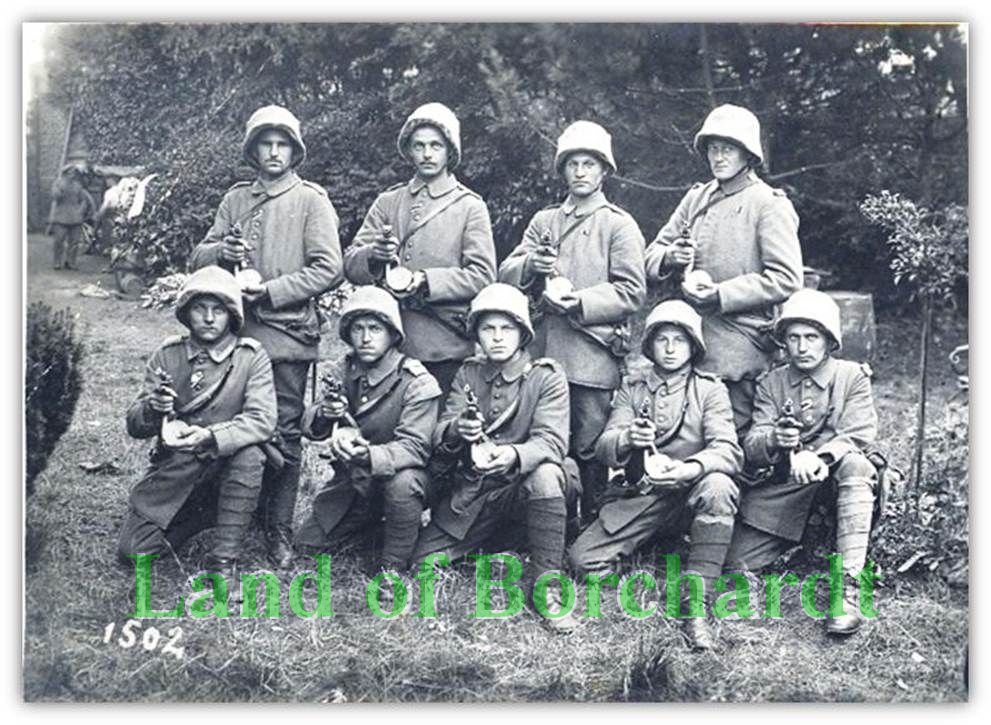
A group of Imperial German army soldiers, kneeling and standing, proudly showing their Artillery Luger rigs, prominently displaying their Trommelmagazines.
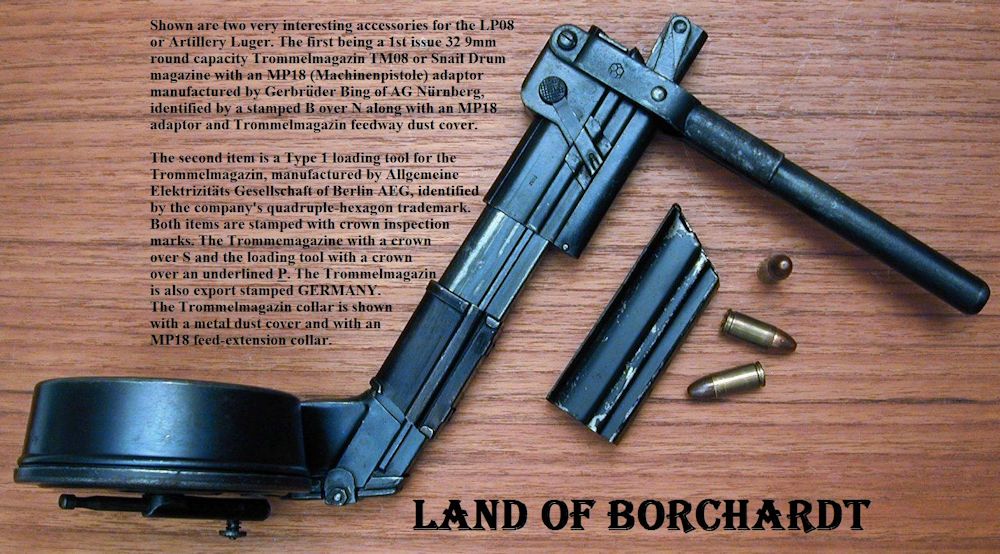
Trommelmagazin B-N with AEG loading tool
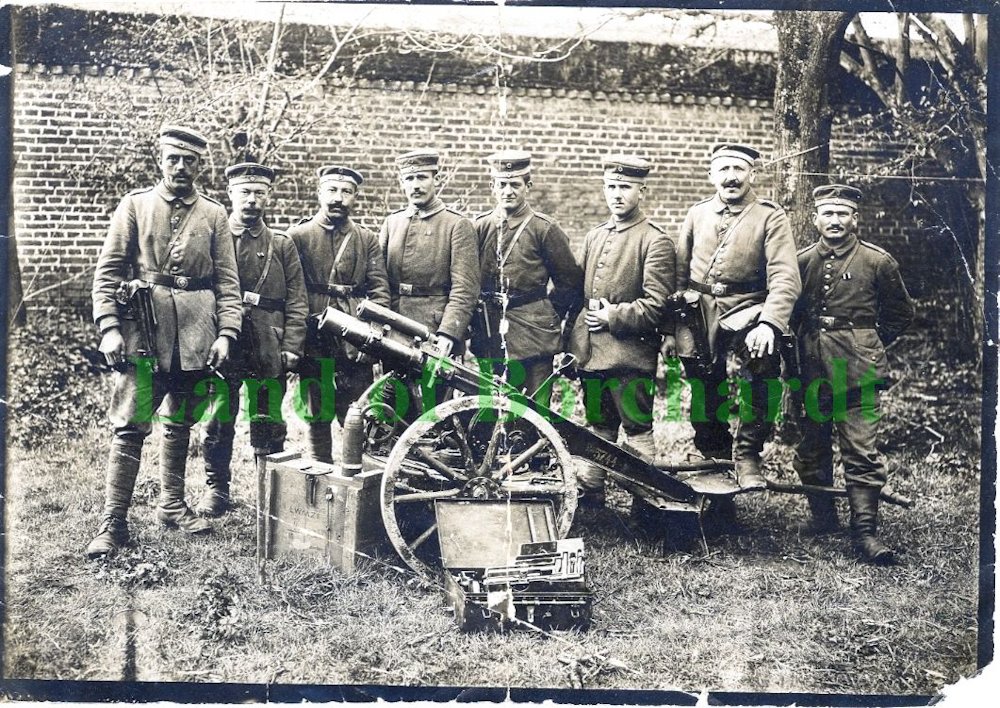
8in. x 6in. photograph of eight Imperial German army soldiers with LP08 rigs

Imperial army soldiers on the front lines trench warfare in 1918 displaying their Artillery Lugers in a “Cross in Saltire” type pose.
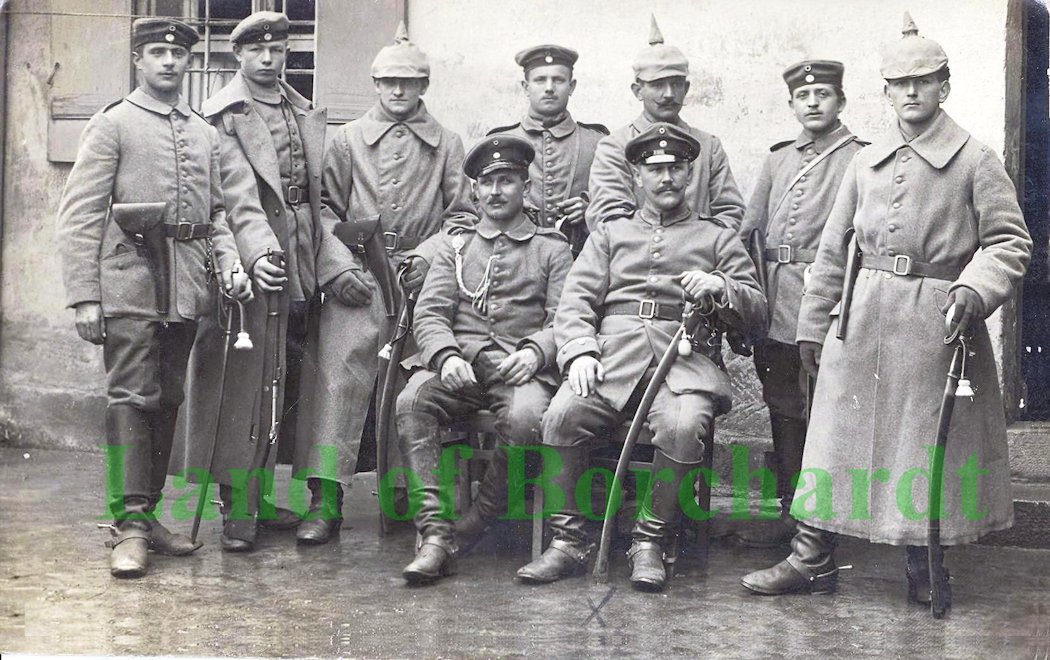
* L. Mun. – Kol. Ers. –Abt. 10. Feld – Artl. – Regt.
Leichte Munitions-Kolonne Ersatz-Abteilung 10 Feld Artillerie Regiment
Light Ammunition Column, Replacement Battalion, 10th. Field Artillery Regiment, garrisoned at Erlangen
|
Pictured is a 1914 – 1916 World War 1 post card mailed to a friend in Nurnberg. The card shows six standing German Imperial army soldiers and two seated officers. Per the circular stamp on the rear, they are of the Light Ammunition Column, Replacement Battalion, 10th. Field Artillery Regiment, garrisoned at Erlangen. The second soldier from the left is holding a Gewehr 91 Carbine, which was meant to be replaced by the new Artillery Luger. Field artillery regiments contained Horse artillery batteries, which explains the spurs on their boots. Based on the two Pickelhaube helmets pictured, dates the picture to no later than 1916. The six standing soldiers are wearing belt loop, cover flap holsters. The message on the back side is personal and is not related to the photograph. Translated postcard message: Sending you this card from far away and hope we’ll see again. Please say greetings to all friends. Kind regards, Sg. Goltz. Goltz is the seated officer with the X mark. The first thought, based on the cover flap, is that the holsters are for the Artillery Luger, but it has been suggested by Dr. G.L. Sturgess that they are M/87 holsters for the RR79 or the M/79 Reichsrevolver. The holster body is indeed for the Reichsrevolver, however, the Reichsrevolver holster cover flap is a different design from the original. The original Reichsrevolver M/79 holster, .ak.a. M/87, coincidently, in addition to housing the M/79 Reichsrevolver, many were also used later for the Artillery Luger, as explained by Sturgess in Pistole Parabellum. Pictured is one such holster, originally made for the Reichsrevolver, as evidenced by the cylinder bulge in the holster body and later used to house an Artillery Luger as evidenced by the long-term cover flap storage impressions of the rear frame and rear link. The 1914 – 1915 multiple use of the M/79 Reichsrevolver (M/87) holster for the Artillery Luger is pictured and described in Pistole Parabellum, Copyright © 2010, Volume III, chapter 44, LP.08 holsters, page 1350, figure 1262 titled: Shortages, Caused by Confusion, Filled with M/87 Revolver Holsters. The figure 1262 caption, however, poses some vexing questions regarding the subject post card photograph holsters. Sturgess states that the M/87 holster for the M/79 Reichsrevolver, in addition to being used, in its original configuration, for the Artillery Luger, some were also specifically modified to better accommodate the LP.08 by adding a magazine pouch to the holster body spine and changing out the cover flap with one designed to cover the magazine pouch entrance on the right by a bucket style end, and to cover the exposed Artillery Luger grip on the left side by extending the cover flap. This modification of an M/87 Reichsrevolver holster is accurately depicted in figure 1262. This leaves the situation of the subject post card holster(s), not being a totally original, unmodified regulation “M/87” holster, due to its replacement, symmetrical full cover flap, yet lacking the added holster body magazine pouch, in other words, another variation. The modification or change-out of the original M/87 cover flap was not needed to holster the Reichsrevolver, as the original regulation version was quite adequate; with the only conclusion remaining is that the “interim” variation modification, albeit these examples without the added holster body magazine pouch was, nevertheless, done to accommodate the Artillery Luger. An alternate scenario is presented by Sturgess, with comments: I agree the holster flaps are not the regulation Prussian M1887 holster pattern (the common RR79 holster), which is what you have. However, the unit is a Bavarian regiment (Leichte Munitions-Kolonne Ersatz-Abteilung 10 Feld Artillerie Regiment or Light Ammunition Column, Replacement Battalion, 10th. Field Artillery Regiment, garrisoned at Erlangen). The Bavarians went their own way with uniform accessories like holsters, and had a long tradition of modifying and updating earlier holsters for all units, especially the mounted artillery. This is not a recorded official pattern, but may have been privately procured - attached is a photo from Harder's book showing a near identical private holster for the RR79. Had they been "officially" converted from RR M 87 holsters to carry lP.08s I am sure the conversion would simply have been to unstitch the flap of the RR holster, and sew a normal P.08 bucket flap in its place. Per figure 1162, which shows a modified M/87 holster to LP.08, that is, at least in this conversion, not exactly what they did, as it is not a true P.08 bucket flap conversion. The armament schedule (Table of Equipment) of such a unit (leichte Munitionskolonne) in 1914 shows only a single P.08 to have been issued, to the Medical Officer, (Sanitätsunteroffiziere – Ambulance officers) all other personnel carrying revolvers - the attached copy of the ToE from Achim Goertz's book on weapon markings shows this clearly, and this is for the front line service battalion, not the reserve battalion, which will have carried more obsolete armament until well into the war, so I feel pretty certain these holsters carried RR79s, not lP.08s. The date of the photo is most probably before March 1916, when the Bavarian artillery finally adopted the Prussian pattern of artillery Pickelhaube with the cannonball finial in place of the spike, and issue of the lP.08 was barely underway in this period, again indicating RR 79s. Pictured are several views of the subject preproduction prototype 1912/13 Artillery Luger, serial number 11 mated with an aftermarket reproduction Artillery luger solid-body holster stock.

|





